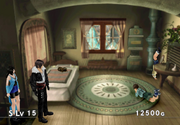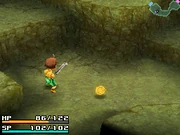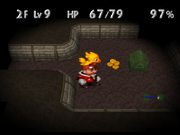
Oh, shut up and help me remodel the Gil page!
- More info on each game on where to obtain Gil quickly, as well as what Gil can be used for per game.
This request can be discussed on the associated discussion page. Remove this notice upon completion.

Gil coins in Final Fantasy X.
Gil (also translated as GP), is the currency in all of the Final Fantasy games. According to Final Fantasy IV, the gil is named after the Gilbert family of Damcyan.[1]
Appearance
Gil is almost never seen in-game. Usually, the only time gil is seen is when using the Gil Toss command. The currency is predominantly circulated in coins of varying value. The only mention of paper gil in the series is in Final Fantasy Tactics A2: Grimoire of the Rift, where Luso delivers a letter containing several gil notes.
In Final Fantasy X, gil coins come in several colors (and presumably metals), and each bears an image on one side and the value of the coin on the other. In Final Fantasy VI and Final Fantasy VII, gil appears as silver coins with a hole through them, while in Final Fantasy V gil coins are gold with a hole.
This suggests that gil is loosely based on the Japanese yen (円) or ancient Chinese coins, with Final Fantasy X's gil coins appearing very similar to yen coins. The yen, along with other Japanese currencies such as the mon, have holes in some of their coins, a trade dating back to feudal times when coins were carried on string.
Usage
Gil is a metric currency, measured in base ten. Beyond this, the exact value of gil varies from game to game. For example, in Final Fantasy IV Potion costs 30 gil, while they cost 250 gil in Final Fantasy VI and 100 gil in Final Fantasy VII. Some items, such as Elixirs, have very low sale prices, usually only 1 gil, meant to discourage the player from selling such rare items. The value of items between individual shops and towns is universal for most games, and items do not change in pricing depending on where the player shops. There are a handful of exceptions to this, allowing the player to earn discounts at some stores, but this happens very rarely.
Gil also has many other uses. The most common of these is the Gil Toss ability, which allows the player to damage enemies by throwing money at them. Gil Toss often does great damage, but at the obvious drawback of costing a great deal of gil. In Final Fantasy X, gil can be used to bribe monsters to leave the battle as well as entice Yojimbo into attacking enemies. In Final Fantasy XII, the Turtleshell Choker accessory allows the equipped party member to cast spells using gil instead of MP.
In Final Fantasy VII, gil and GP are treated as separate currencies. At the Gold Saucer amusement park, GP is used to pay for many attractions, while others charge gil. GP is also used to buy items from the park. GP cannot be bought, but a man randomly appears outside the park who sells the player GP for 100 gil apiece. Otherwise, GP can only be acquired by winning the Saucer's minigames.
Acquiring
Gil can universally be found in treasure chests and awards for subquests. Most Final Fantasy games allow gil to be won from enemies, but there are exceptions. In Final Fantasy VIII, the player earns a regular salary based on their SeeD ranking. In Final Fantasy XII, monsters do not drop gil but instead drop loot, which can then be sold. In Final Fantasy XIII players have to find Item Spheres containing gil.
In some games, gil can also be stolen from monsters. Some games offer the player the chance to win more gil from battles by using certain accessories or abilities, and some penalize the player an amount of gil for fleeing from battle. In all of the above instances, items can be sold for gil as well.
Naturally, in games where monsters leave gil, stronger monsters usually leave more. The reverse applies for games that penalize the player for fleeing - the stronger the monsters they are fleeing from, the more gil they will lose.
Final Fantasy
Late game dungeons, such as the Chaos Shrine and Flying Fortress, contain monsters giving large amounts of gil, such as Black Knights, which give 1,800 gil a piece and attack in groups. Gil is also found in many treasure chests throughout these dungeons, and if a player is wishing to conserve gil, they should not buy magic until they can afford it.
Final Fantasy II
Template:Sec-stub
Final Fantasy III
Template:Sec-stub
Final Fantasy IV
In the Final Dungeon, you can fight Behemoths, and Ahriman for 65000 gil apiece. The same also applies to Red Dragons (only in GBA version). Template:Sec-stub
Final Fantasy V
The optional area, Gil Cave, yields plenty of gil, but is guarded by the dangerous Gil Turtle. The cave can be completed multiple times.
Another place with good gil is the Drakenvale where Zombie Dragons can be fought. They drop Dragon Fangs that can be sold for good gil.
Lastly, in the Castle of Bal, the Objet d'Art drops 507 gil a piece and attacks in groups of two or five. They can be easily defeated with Gold Needles or Level 5 Death.
Final Fantasy VI
The best way to earn money is to wait until the World of Ruin and fight Cactuars in the Maranda Desert. They can easily be defeated with Blitz, Tools, or Bushido techniques, as they give 10,000 gil. Equipping Relm's Cat-Ear Hood doubles the gil earned for 20,000 gil each battle.
If the player needs gil in the World of Balance they should go to the southern continent and defeat Fossil Dragons with Sabin's Aura Cannon, as they give 1,870 gil a piece.
Final Fantasy VII
An easy way to make plenty of gil is to sell a mastered All Materia to earn 1,400,000 gil. One can also exploit the W-Item Duplication Bug to duplicate items and then selling them for money, such as Sylkis Greens.
Final Fantasy VIII

In Final Fantasy VIII, gil is earned as the salary paid to SeeD operatives.
Final Fantasy VIII is the first game in the main series where the player doesn't earn money from battles. Instead, they are paid a regular salary once they become a SeeD. The amount of money paid depends on their SeeD rank.
The salary is paid at regular intervals dependent on the amount of steps the player has taken. Since the player earns no steps during Laguna flashbacks, they can't get paid during those scenarios. Due to the fact that most steps are accumulated by driving a car or riding a chocobo, the player can make quick money by riding either one in circles on the world map. However, if the player doesn't fight battles in between payments, their SeeD rank will tend to decrease.
The player can easily make plenty of gil with Carbuncle's Recov Med-RF ability. The player can fight Mesmerizes on the Esthar continent prior to the Lunar Cry, or Trabia anytime thereafter, although they are far more common in Esthar. This will yield the player plenty of Mesmerize Blades which can be refined into Mega-Potions (1 Blade refines into 2 Mega-Potions). 100 Mega Potions sell for 500,000 gil, and are quite quick to acquire. The trick works better with the Mug ability.
It is also possible to rapidly generate gil without having to fight any battles. The player can purchase 100 Tents and refine them into 25 Mega-Potions (again with Recov Med-RF), which will then sell for more than the Tents cost, giving a net profit of 125,000 gil per iteration. This method becomes considerably more effective once the player has Tonberry's Haggle and Sell-High, increasing the profit to 180,000 gil per iteration.
Final Fantasy IX
Gil can easily be harvested by synthesizing the Cotton Robe and then selling it. Each time one synthesizes 99 Cotton Robes, they make 60,000 gil. As money is most useful early in the game, prior to getting the Blue Narciss, it can be done easily three times, once per disc:
On the first disc the player can buy Wrists in Dali, Steepled Hats in Lindblum and synth them in Lindblum. On the second disc the player can buy Steepled Hats in Cleyra (at the end of disc 1), buy Wrists in Dali on the way to Treno and synth them in Treno. On the third disc the player can buy Steepled Hats in the Black Mage Village, buy Wrists while getting the Burman Coffee during the Card Tournament and synth in Treno.
Wrist costs 130 gil, and a Steepled Hat costs 260 gil. It costs 1000 gil to synthesize a Cotton Robe and they sell for 2000 gil each. The player makes 610 gil profit each time.
Final Fantasy X
The player can sell equipment pieces dropped by enemies for money, as most of the time they aren't needed for actually equipping. By battling the One-Eye at the Monster Arena and selling its drops yields a lot of gil fast. The Mimics in Omega Ruins also drop a lot of gil, especially with the Gillionaire ability.
Before acquiring the airship the player can make fast money by fighting Epaajs outside the Cavern of the Stolen Fayth that drop SOS Overdrive weapons, which sell for up to 75,187 gil depending on the number of empty slots.
Armor can also be customized to yield a lot of gil when sold. The player can buy Tetra Armor from Kilika best suited for this purpose. For example, Tetra Armor customized with HP+30% will sell for 28,406 gil, and it can be customized fairly easily with only one Stamina Tonic. A lot of rewards earned from the Monster Arena monster capturing can be used for customizing armor and then selling the results.
Final Fantasy X-2
The Thief's Nab Gil ability comes useful early in the game, especially if the player wants to pay off O'aka's debt. If the player encounters the Angra Mainyu on the Bikanel desert while digging, they can steal big sums of gil from it every time it is encountered. After O'aka's debt has been paid, the player can buy his merchandise and then sell it to Barkeep for a profit.
Final Fantasy XII
Most Gil in the game is obtained by selling loot dropped and stolen from monsters. The value of the loot can range over a wide variety of prices. More valuable loot can be obtained by acquiring a large chain of monsters. Monsters may also drop weapons and/or armor which also can be sold.
While usually in small amounts, Gil also can be found in various treasure caskets around the world. The amount will normally range from 10-300.
Gil is also always part of the reward for hunting marks. This amount usually ranges in the thousands. A piece of loot is also obtained usually from hunts which can be sold for a price as well.
Final Fantasy XIII
While Gil is not obtained after battle, as with most other games, it is acquired frequently in treasure chests and from selling unneeded items such as weapons and components such as Platinum Ingots.
The Estheim Residence in Palumpolum can be a cash grinding place after PSICOM raids it, as the officers battled inside drop Incentive Chips. They can be sold for 2,500 gil at the save station inside, and the officers are reset when the player attempts to retry battling the Havoc Skytank or circles the room.
Riding the chocobo on the Archylte Steppe often finds items that sell for a lot of gil. Doing the Bhakti sidequest also yields good selling items.
Final Fantasy XIII-2
Gil is seen to be obtained after battle, at the Battle Results screen.
Final Fantasy Crystal Chronicles: Ring of Fates

Sometimes monsters will drop gil and you are able to pick it up.
Template:Sec-stub
Chocobo's Dungeon 2

Template:Sec-stub
Final Fantasy: The 4 Heroes of Light
Gil can be earned by selling Gems, by shopkeeping in Urbeth, by selling items dropped by enemies and some gil is also found as treasures. The player can usually generate gil fast by opening a shop in Urbeth and buying things from local vendors and then selling it for profit.
Dissidia 012 Final Fantasy
The most practical source of gil is generally the Confessions of the Creator scenario in Story Mode, where the player can obtain valuable equipment, which can be sold, as well as enemies (especially Assist characters) carrying a large quantity of gil. By making use of the Glorious Gold combination, the Beckoning Cat accessory and the calendar bonus, the amount of gil earned can be boosted.
If the player is willing to invest the time and effort to set it up, the maximum KP run of the Forsaken Lands gateway offers 54,720 KP. This can be exchanged at the Land of Discord Moogle Shop for a total of 182 Blue Moons (300 KP apiece); these can then be sold in the shop for 91,400 gil each, earning approximately 16.6 million gil. This is more than enough to buy 33 Lores, which are the most expensive items in the game.
Since the Land of Discord Moogle Shop requires a relatively large detour to reach it, a slightly less lucrative but more accessible option is to exchange the KP at the Elven Snowfields Moogle Shop, for a total of 273 Heike's Blades and/or Heike's Shields (200 KP apiece); these can then be sold in the shop for 55,930 gil each, earning approximately 15.3 million gil. Adding the gil earned while traversing the Forsaken Lands gateway can increase this figure to ~15.5 million, enough to buy 31 Lores.
On the player's Bonus Day, the Blue Moon has a 10% discount and the Heike's items have a 5% discount, increasing the gil earned to 18.6 million or 16.1 million, respectively. If the Bonus Day also happens to have the main shop buying for 10% more than usual, the result is 20.4 million gil or 17.7 million gil, respectively.
Other Appearances
Gil makes an appearance in another title from Square Enix, Gyromancer.
References
Template:Miscellaneous
